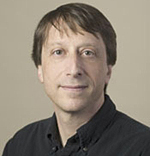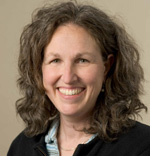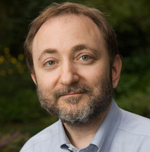October 10, 2012 - By Erin Digitale
The awarding of the Nobel Prize in Chemistry to Brian Kobilka, MD, professor and chair of molecular and cellular physiology at the Stanford University School of Medicine, prompted congratulations, reflection and advice from colleagues. What follows is a sampling of thoughts gathered by writers in the medical school's Office of Communication & Public Affairs.
Roger Sunahara, PhD, associate professor of pharmacology at the University of Michigan in Ann Arbor, worked with Kobilka to refine the conditions needed to crystallize the G-protein-coupled receptors together with the G proteins they activate.
"Dr. Kobilka was a competitor of mine," Sunahara said. "We were basically trying to do the same thing in the early 2000s. I thought we could help each other dramatically even though we were competing."
Sunahara and Kobilka began collaborating after talking at a conference in the mid-2000s. "It was a funny story. After the conference ended on a Friday, we went back — him to California and me to Michigan — and talked to our labs about a possible collaboration," Sunahara said. The next Monday, Kobilka mailed some purified receptor to Sunahara's lab. By the following Friday, Sunahara's team had solved a problem the Kobilka lab was having with activating the receptor.

William Weis
"We suddenly realized we were going to be a good team," Sunahara said with a laugh, adding, "He's a great guy. You talk to him for a couple of minutes, and you realize he's a genuine scientist; he wants to advance the field. He's always commanded a tremendous amount of respect from other scientists, both for his science and his integrity. I'm very honored to work with him."
William Weis, PhD, the William M. Hume Professor in the Stanford School of Medicine andprofessor of structural biology, is an X-ray crystallography expert who has collaborated with Kobilka since the mid-1990s.
"Brian Kobilka is great," Weis said. "He's always thinking about every possible approach to try to crack the problem. He's really creative and really focused but an incredibly nice person; incredibly low-key and humble. It's an absolute pleasure to work with him."
Weis recalled seeing the crystallized molecular structure of a G-protein-coupled receptor that he helped Kobilka solve in the mid-2000s. "You do all this work and get an electron density map, an image of the molecule," Weis said. "I remember the very first time we could see the helicies of the receptor. That was the most exciting time because then we knew we really had it."
Conrad Firling, PhD, professor emeritus of biology at the University of Minnesota-Duluth, taught the introductory biology class that Kobilka took as a freshman at UMN in 1974, and later mentored Kobilka in his first research projects as an undergraduate.
"In those days, to have an undergrad in a lab was quite unique," Firling said, noting that the freshman Kobilka started with the lowliest lab job, washing glassware. But Kobilka quickly progressed to more complex projects, publishing and presenting his first research while still an undergraduate. "He obviously had the knack for it, and certainly had the intelligence," Firling said, adding, "Brian is a very honest, down-to-earth, friendly individual but absolutely uncompromising in his science. If I had to indicate a model for modern scientists, it would be Brian."

Miriam Goodman
Kobilka's willingness to surmount any obstacle to conducting an experiment was evident even in the early days, Firling said. "I was a young faculty member, and we didn't have much equipment. We needed a sterile hood. I came into the lab one morning and in the corner was the ugliest thing you could imagine. Brian had gone to the lumberyard, and gotten plastic from his father's bakery, and constructed this sterile hood to do his experiments. That's the type of guy he was. He was so much fun in the lab."
Firling said that he was "ecstatic" to learn of Kobilka's Nobel Prize.
Miriam Goodman, PhD, is associate professor and associate chair in Stanford's Department of Molecular and Cellular Physiology, which has Kobilka as its chair.
"He's incredibly generous with his knowledge and his time," Goodman said. "He's happy to try to help in his area of expertise, or even if it's not."
She added: "I'm working to gain expertise in structural biology and have asked him 'What did you do to teach yourself?' He gave me tips: 'Go to this website, use this software, don't use that software.' Being part of a research community that's pushing the boundaries of what is known, he's one of those extremely generous colleagues who helps you avoid pitfalls."
Andrew Fire, PhD, professor of pathology at the Stanford School of Medicine and Nobel laureate in medicine or physiology in 2006, attended the news conference for Kobilka at the Li Ka Shing Center for Learning and Knowledge.

Andrew Fire
Fire offered some thoughts on how winning a Nobel doesn't entirely change a scientist's life. "Winning the Nobel doesn't mean that every grant is going to get approved," he said. "You shouldn't be able to convince somebody that something is true just because you have the Nobel. What it does mean is that if you have something you want to say, people will listen. There's that media attention —that has been somewhat useful." He noted, for instance, that he works with two other medical school Nobel laureates — Paul Berg, PhD, and Roger Kornberg, PhD — to champion basic science. "That press attention has helped, " he said.
Fire also said that he thought it was great that this Nobel award is for a very recent piece of work. "Often the award is for work that is done 30, 40 years ago," he said. And he also observed that Kobilka's background was significant for the Nobel Prize in Chemistry. "His background is in medicine," Fire said. "He was very modest about that, but his training is really tremendous."
Fire added that he is still waiting to decide what to do with the money he won from his Nobel Prize. He hasn't spent any of it. He said it could come in handy if he happened to go bankrupt.
Georgios Skiniotis, PhD, assistant professor of biological chemistry and research assistant professor of the Life Sciences Institute at the University of Michigan in Ann Arbor, also collaborated with Kobilka.
"He's a brilliant scientist, an extremely clever person," said Skiniotis. "This is combined with dedication, an everyday and constant effort to achieve a target. He's also very open to collaboration, engaging, works with a number of people. That has been a huge key to his success."
Skiniotis recalled helping Kobilka devise the conditions needed to crystallize G-protein-coupled receptors so that their image could be recorded. "We had run out of options, but I looked back at my notes and said, 'Well, maybe we should try this.' I remember him calling the next day and saying, 'We got the crystals and they diffracted so well.' We were just ecstatic about it."
Richard Tsien, DPhil., the George D. Smith Professor Emeritus in Molecular and Genetic Medicine at Stanford and the Druckenmiller Professor of Neuroscience and director of the Neuroscience Institute at New York University Medical Center, taught Kobilka at Yale medical school and later recruited him to Stanford.
"That is just amazing news," Tsien said about Kobilka's Nobel. "Fantastic!"
Tsien recalled: "I first taught Brian when he was a medical student at Yale — a skinny kid from Minnesota who was very conscientious, keen to know everything he could possibly know about being a good doctor and a good scientist. I remember him being particularly gaunt and definitely an ectomorph. He asked lots of questions after lectures, even though I didn't have the feeling he was going to become an electrophysiologist.
"Fast forward a few years to my time starting the Department of Molecular and Cellular Physiology at Stanford, when I had the opportunity to collaborate with the Department of Medicine in recruiting someone interested in doing research at the borderline of clinical work and basic science. I learned that Brian was on the job market, and he stood out for his spectacular work done with his Tong Sun, all in the Lefkowitz lab, where they fearlessly took on the cloning of various beta adrenergic receptors. I was really impressed by how helpful and thoughtful and enterprising he was in going after big problems."
Mark von Zastrow, MD, PhD, professor of psychiatry and of cellular and molecular pharmacology at the University of California-San Francisco, was a postdoctoral scholar in Kobilka's lab at Stanford in the early 1990s.
"He's fabulous; we had a great time, and I think everyone who's ever worked with him would say the same," von Zastrow said. "Brian's scientific insight and sense of important questions is very impressive. It was helpful as a postdoc for learning how to spot and pick up on interesting questions. Also, he was always very concerned about the people in his lab, in terms of their professional development and what would be useful for them. For instance, I gave some talks early in my career that he could have done, but he let me do them instead."
"He's very serious and very driven, and that sort of rubs off on people because he's inspiring to work with. But he also has a human, playful side that was manifest in little jokes we would play on each other in the lab." What kind of jokes? Von Zastrow hated labeling test tubes, he recalled. For one assay that von Zastrow regularly performed for his postdoctoral project, he would keep track of which tube was which by positioning them in a specific way in the test tube rack. Then, he'd count the tube numbers under his breath while adding reagents to each tube. "I would be sort of focused on this, and Brian liked to walk up behind me and start randomly reciting numbers. He did it in a way that wouldn't destroy the experiment, but the opportunity to get my goat was something he couldn't resist."
Von Zastrow concluded, "We're all very pleased for Brian – this couldn't happen to a nicer or more deserving guy."
About Stanford Medicine
Stanford Medicine is an integrated academic health system comprising the Stanford School of Medicine and adult and pediatric health care delivery systems. Together, they harness the full potential of biomedicine through collaborative research, education and clinical care for patients. For more information, please visit med.stanford.edu.